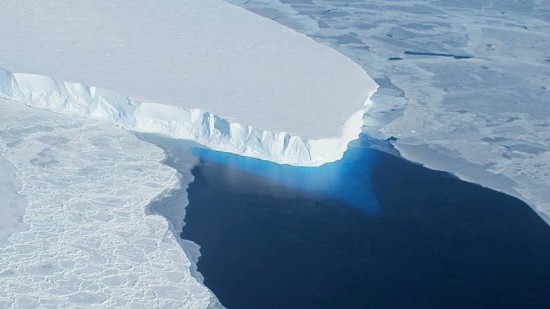
Three different reports, two in the past two weeks, and one published back in April, point to just how destabilizing global warming has become for our polar extremes. The first report is NOAA’s 2021 Arctic Report Card. The second is a study from the University of Colorado Boulder about an Antarctic glacier. And the third comes from a NASA satellite called GRACE that helped researchers show that the north and south poles are moving because of water distribution changes from groundwater and ice loss attributed to human activity and anthropogenic climate change.
What NOAA’s Arctic Report Card Says
The 16th annual report released by NOAA, the U.S. National Oceanic and Atmospheric Administration, describes rapid and dramatic changes to land and ocean conditions in the Arctic region. Findings include:
- The average surface air temperature over the Arctic in the past year was the seventh warmest on record.
- The Arctic continues to warm at a pace more than twice that of the rest of the planet.
- Greenland has been on a consecutive string of ice mass loss since 1998.
- Rainfall falling on Greenland’s ice sheet at an elevation of more than 3,000 metres (10,500 feet) was observed for the first time in recorded history.
- Post-winter sea ice in the Arctic Ocean in April 2021 reached the lowest coverage since records began in 2010. The decline in Arctic sea ice extent since 1979 is considered to be an iconic indicator of global warming.
- Sea ice loss is allowing shipping and other commercial activity to further damage the Arctic environment.
- The Arctic Ocean is seeing rapid acidification evidenced by severe dissolution of the shells of sea snails.
An Antarctic Glacier Threat
The Thwaites Glacier called the riskiest one in West Antarctica, extends 120 kilometres (75 miles) along the coastline and is approximately the size of the United Kingdom or Florida. Its base rests on bedrock 1,000 metres (3,300 feet) below sea level and at its seafront is a floating ice shelf that extends into the Southern Ocean. The glacier’s front is held in place by an underwater ridge that allows warmer ocean water to erode the ice shelf and the main glacier itself. The result can be seen in an increasing number of massive fractures indicating a potential future glacial collapse. But when?
The latest study out of the University of Colorado Boulder, published on December 13, 2021, notes that the Thwaites Glacier has doubled its flow speed in the last 30 years. And because the glacier rests on bedrock below sea level, as it moves downhill towards the ocean at current speeds of better than 1.3 kilometres (0.8 miles) per year, it is building up a significant ice mass at its front that is likely to lead to massive icebergs calving off its edge. When the buildup reaches catastrophic conditions it causes ice-cliff failure which has been observed with smaller glaciers and ice shelves on the Antarctic Peninsula.
The Thwaites Glacier, however, isn’t small. What happens to it is a barometer of how global warming is affecting the southern continent. A team of 100 scientists are studying its vulnerability and are modelling its ice flows. They forecast a high likelihood of a chain-reaction fracturing and collapse occurring within several decades. If the ice shelf in front of the main body of the glacier breaks up then the entire ice mass could follow raising global sea levels 65 centimetres (approximately two feet) within a few years and threatening millions living in coastal cities and along coastlines.
Climate Change is Moving the Earth’s Poles
The last headline is one I needed to get my head around before writing about it. At first, I thought the story to be highly unlikely. But having done additional research about the periodic axial wobble that characterizes our planet, I am convinced that human activity is leading to a change in the angle of tilt
Where’s the evidence? Since 2002, GRACE, a NASA Earth observation satellite, has been studying the presence of water in liquid and ice form on the Earth’s surface looking at its distribution and changes in pattern. And what it has detected is a correlation between groundwater loss and ice melt mass and changes in the orientation of the Earth’s poles.
We have known for a considerable time that the magnetic poles wander subject to the powerful magnet created by the Earth’s molten iron core as it spins. But GRACE is detecting polar drift of the axial kind since the 1990s and has found a link to global warming and human activity.
Where global warming has caused surface ice mass to melt, human activity is depleting groundwater on a massive scale. The end result, the axis is moving. The research comes from an analysis of the satellite data and was published in April of this year by scientists at the Institute of Geographic Sciences and Natural Resources at the University of Chinese Academy of Sciences, in Beijing.
What the study confirms is how much our Earth spins like a top. When weight distribution on a top is altered it will lean and wobble. That’s the best way to describe the phenomenon being observed here with the Earth’s axis being affected by changes to groundwater distribution and the melting of alpine and continental glaciers at the two poles.
How much has the Earth’s pole drifted? It recently has shifted from southward to eastward cant with the speed increasing 17 times faster between 1995 and 2020. And now the scientists are using this research to look back in time and study to correlate loss and growth of ice mass with paleoclimate change.








